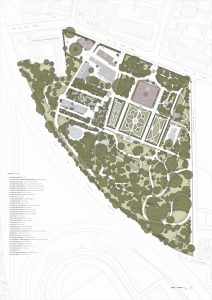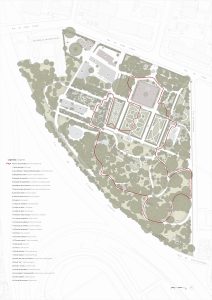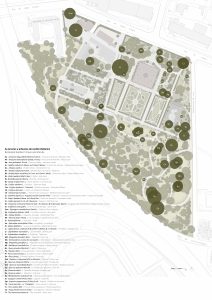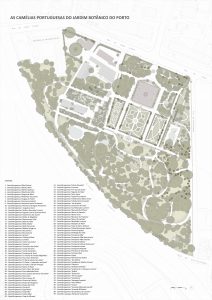PERCURSOS E MAPAS
Plano Geral do Jardim Botânico da Universidade do Porto
O Jardim Botânico da Universidade do Porto, com uma área de cerca de 4 hectares, é um espaço eclético, ordenado e desenhado, com elevado interesse ecológico, estético e referencial. É um lugar rico em plantas, histórias e memórias, onde se evidenciam as intervenções do final do séc. XIX e da segunda metade do séc. XX.
Está organizado em três patamares com caraterísticas muito distintas. No primeiro patamar, situam-se os jardins formais, compartimentados por altas sebes de camélias centenárias, destacando-se os Bosquetes, o Jardim do Xisto, o Jardim do Peixe, o Roseiral e o Jardim dos Jotas. No segundo patamar, encontram-se o Jardim dos Catos e as estufas. O terceiro patamar, a cotas mais baixas, acolhe o Arboreto, a presa e o lago grande.
Percurso Recomendado
Os Bosquetes (3, 4 e 5 no mapa) são pequenos conjuntos arbóreos ordenados que evidenciam traçado e composição pseudo-naturalista, com uma ambiência de penumbra e luz coada.
O Roseiral (10 no mapa) e o Jardim dos Jotas (9 no mapa) são jardins formais, delimitados por sebes altas de japoneiras (Camellia japónica L.) talhadas com um traçado de base geométrica, à moda do final do séc. XIX. O primeiro desenvolve-se como um enorme tapete, a sul da Galeria da Biodiversidade (2 no mapa), enquanto que o segundo apresenta canteiros desenhados por sebes baixas de buxo em forma de jota, as iniciais de João e Joana Andresen, antigos proprietários da Qquinta do Campo Alegre.
O Jardim dos Catos (18 no mapa) é um jardim xerofítico criado nos finais de 1950, que alberga uma interessante coleção de catos e suculentas, sendo rematado a sul pelas estufas desértica e tropical.
O Arboreto (14 no mapa), situado a sul, a cotas mais baixas e ocupando cerca de metade do Jardim, é a zona que alberga plantas lenhosas das mais diversas regiões bioclimáticas do mundo.
O Jardim do Xisto (13 no mapa) foi construído nos anos 1950 no lugar do “ténis”, com um traçado geométrico moderno suavizado pela irregularidade rústica dos materiais. Centrado em pequenos lagos de cultivo de nenúfares e outras plantas aquáticas, evoca ainda as quentes paisagens do Douro.
O Jardim do Peixe (12 no mapa) é um espaço fechado por sebes altas de japoneiras, feito de canteiros de relva bordejados a buxo talhado (“parterre a l’anglaise”). Criado nos anos 1950, na antiga espargueira da quinta, o seu nome atual deve-se à forma do canteiro central.
Uma Seleção de 50 Árvores
A proximidade do Atlântico e um substrato granítico criam condições favoráveis ao cultivo de uma comunidade vegetal variada, robusta e multiestratificada, que integra plantas das mais variadas regiões bioclimáticas do mundo. Na coleção botânica estão representadas plantas de 514 géneros e mais de 1100 espécies. Entre estas, destacam-se alguns exemplares de árvores notáveis de espécies raras, exóticas e autóctones, incluindo cedros (Cedrus spp.), araucárias (Araucaria spp. Juss.), liquidâmbares (Liquidambar styraciflua L.), carvalhos (Quercus spp. L.), tílias (Tilia spp.), tulipeiros (Liriodendron tulipifera L.), cameleiras (Camellia spp. L.), rododendros (Rhododendron spp.), sequoias (Sequoia sempervirens (D.Don) Endl), faias (Fagus spp. L.), biscofias (Bischofia spp. Blume), Braquiquito (Brachychiton spp. (Schott & Endl.).
Uma Seleção de 50 Espécimes Autóctones
Nos últimos anos o Jardim Botânico tem apostado no enriquecimento da sua coleção de espécies autóctones. São plantas que existem naturalmente no território português e são muito pouco utilizadas como ornamentais, mas muito interessantes por estarem adaptadas às nossas condições ambientais e promoverem a biodiversidade.
A presença de espécies autóctones faz-se sentir por todo o Jardim, destacando-se: os exemplares notáveis, como o grande sobreiro do Arboreto e os Carvalhos-alvarinhos do Jardim do Liquidâmbar e do Jardim do Xisto; a bordadura mista que rodeia a Galeria da Biodiversidade, composta por conjuntos de árvores, arbustos e herbáceas de espécies típicas das paisagens do nosso país; o Jardim do Xisto, que representa as quentes paisagens do Douro, com os seus muros e calçadas de xisto, vinhas, medronheiros, zelhas e rosmaninho; e a coleção de carvalhos autóctones que se iniciou no Jardim dos Anões e no Arboreto.
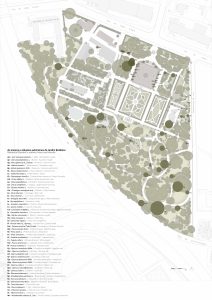 Ver Uma Seleção de 50 Espécimes Autóctones
Ver Uma Seleção de 50 Espécimes Autóctones
Camélias Portuguesas
Ao longo de todo o Jardim as camélias são uma presença constante, embelezando-o com as suas flores nos meses mais frios. Na sua coleção existem 25 espécies do género Camellia, algumas das quais conhecidas pela sua utilização na produção de chá, e cerca de 690 pés de cameleiras (Camellia japonica L.), das quais 99 são de origem portuguesa. Grande parte desta coleção foi plantada no séc. XIX, tendo os exemplares/cultivares sido disposto/as de uma forma invulgar, em sebe talhada, e mantidas, no arboreto, em crescimento livre. Em 2020 o Jardim Botânico da Universidade do Porto foi distinguido com o estatuto de International Camellia Garden of Excellence pela International Camellia Society.
PATHS AND MAPS
General Plan
The Botanical Garden of the University of Porto is an eclectic space, ordered and designed with high ecological, aesthetic and referential interest. It is a place rich in plants, stories, and memories, where the interventions carried out in late 19th century and the second half of the 20th century, are distinctly marked.
It is currently organized in three tiers with distinct features. The first tier includes the formal gardens, separated by high hedges of centenary camellias. The formal gardens are divided into several spaces: the bosquets, the Shale Garden, the Fish Garden, the Rose Garden and the “J’s” Garden. On the second tier lays the outdoor Cactus Garden and the greenhouses. The third level — the lowest one — comprises the arboretum, the fernery, the reservoir and the large pond.
Recommended Path
The Bosquets (3, 4 e 5 in the map) are small ordered woods with a naturalistic composition, casting an ambiance of shade and faint light.
The Rose Garden (10 in the map) and the “J’s” Garden (9 in the map) are formal gardens delimited by high hedges of ancient camellia cultivars with a symmetrical tracing of the late 19th century. The first garden unfolds like a large carpet, just south of the Hall of Biodiversity (2 in the map), and the second one has beds designed by low J-shaped boxwood hedges – the initials of João and Joana Andresen, former owners of the Campo Alegre estate.
The Cactus Garden (18 in the map) is a xerophytic garden, created in the late 1950s, and housing an interesting collection of cactus and succulents, limited at south by desert and tropical greenhouses.
In the Arboretum (14 in the map), located south, at lower levels and occupying approximately half of the Garden, woody plants of various bioclimatic regions of the world coexist.
The Shale Garden (13 in the map) was built in the 1950s with a modern geometric layout softened by the rustic irregularity of the stones present therein. Marked by small lakes used for the cultivation of water lilies and other aquatic plants, it also evokes the warm Douro landscapes through the vines, shrubs and herbaceous species from this Portuguese region.
The Fish Garden (12 in the map) is a space enclosed by high hedges of camellia, made of grass beds bordered by low boxwood hedges (“parterre a l’anglaise“). Created in the 1950’s, the garden owes its name to the shape of the central flowerbed.
A selection of 50 Trees
Both the proximity of the Atlantic Ocean and a granite substrate create favourable conditions for the cultivation of a diverse, vigorous and multi-layered plant community. The Garden integrates species of several bioclimatic regions of the world. The botanical collection contains plants of 514 genus and more than 1100 species. Among these, there are some examples of remarkable trees, of rare, exotic and indigenous species, such as cedars (Cedrus spp.), araucaria pines (Araucaria spp. Juss.), sweetgums (Liquidambar styraciflua L.), oaks (Quercus spp. L.), lindens (Tilia spp.), tulip trees (Liriodendron tulipifera L.), camellias (Camellia spp. L.), rododendrons (Rhododendron spp.), California red-woods (Sequoia sempervirens (D.Don) Endl), beechs (Fagus spp. L.), bishopwoods (Bischofia spp. Blume) and Bottle trees (Brachychiton spp. (Schott & Endl.).
A Selection of 50 Native Specimens
In the last few years, the Botanical Garden has been investing in the enrichment of its native species collection. These species, which naturally exist in Portugal, are rarely used as ornamental plants. However, they are very interesting because they are adapted to our environmental conditions and can promote biodiversity.
The presence of native species is noticeable throughout the Garden. Of the many species cultivated, some do stand out: remarkable trees, like the big cork oak of the Arboretum and the oak-trees of the Liquidambar’s Bosquet and Shale Garden; the mixed border that surrounds the Hall of Biodiversity, composed of sets of trees, shrubs and herbaceous species typical of Portuguese landscapes; the Shale Garden, which represents the warm Douro landscapes, with its shale walls and sidewalks, vineyards, strawberry trees, and lavender; and the collection of native oaks, which we begun to build in the Dwarves’ Garden and Arboretum.
 A Selection of 50 Native Specimens
A Selection of 50 Native Specimens
Portuguese Camellias
Camellias are ever-present throughout the Garden, embellishing it in the colder months with their flowers. This collection bares 25 species of the genus Camellia, some of which known for their uses in the production of tea, and about 690 specimens of Japanese camellias (Camellia japonica L.), of which 99 are of Portuguese origin. Much of this collection was planted in the 19th century, and the specimens/cultivars were arranged in an unusual way – in carved hedges –, and left to grow freely in the Arboretum. In 2020, the Botanical Garden of the University of Porto was distinguished with the status of International Camellia Garden of Excellence by the International Camellia Society.
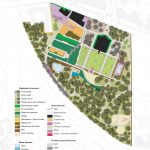 Habitat mapping – Site descriptors
Habitat mapping – Site descriptors


